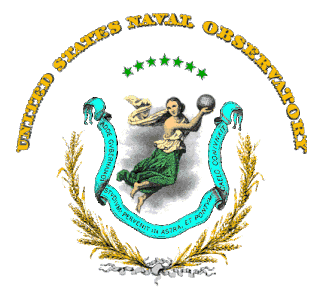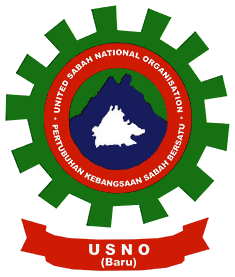
A star catalogue is an astronomical catalogue that lists stars. In astronomy, many stars are referred to simply by catalogue numbers. There are a great many different star catalogues which have been produced for different purposes over the years, and this article covers only some of the more frequently quoted ones. Star catalogues were compiled by many different ancient people, including the Babylonians, Greeks, Chinese, Persians, and Arabs. They were sometimes accompanied by a star chart for illustration. Most modern catalogues are available in electronic format and can be freely downloaded from space agencies' data centres. The largest is being compiled from the spacecraft Gaia and thus far has over a billion stars.

The United States Naval Observatory (USNO) is a scientific and military facility that produces geopositioning, navigation and timekeeping data for the United States Navy and the United States Department of Defense. Established in 1830 as the Depot of Charts and Instruments, it is one of the oldest scientific agencies in the United States, and remains the country's leading authority for astronomical and timing data for all purposes.

The Omo River in southern Ethiopia is the largest Ethiopian river outside the Nile Basin. Its course is entirely contained within the boundaries of Ethiopia, and it empties into Lake Turkana on the border with Kenya. The river is the principal stream of an endorheic drainage basin, the Turkana Basin.

The Omo Kibish Formation or simply Kibish Formation is a geological formation in the Lower Omo Valley of southwestern Ethiopia. It is named after the nearby Omo River and is subdivided into four members known as Members I-IV. The members are numbered in the order in which they were deposited and date between 196 ka ~ 13-4 ka. Omo Kibish and the neighboring formations have produced a rich paleoanthropological record with many hominin and stone tool finds. The Kibish formation, in particular, is most notable for Richard Leakey's work there in 1967 during which he and his team found one of the oldest remains of anatomically modern Homo sapiens. Known as Omo Kibish 1, the fossil was dated to 196 ± 5 ka old and is among two other Omo remains that were found in Member I. The Omo fossils were more recently re-dated to approximately 233,000 ka old. In the early 2000s a research boom enriched the knowledge base about the Kibish Formation. Study of the faunal remains and stone tools provided insight into the archeological associations of Homo sapiens and thereby their behaviors and the complex environmental contexts in which they lived and evolved.
Selamago is a woreda in the Southern Nations, Nationalities, and Peoples' Region of Ethiopia. Part of the Debub Omo Zone, Selamago is bordered on the south by Nyangatom, on the west and north by the Omo River which separates it from the Bench Maji, Keffa and Konta, on the northeast by the Gamo Gofa, on the east by the Basketo and Bako Gazer, and on the southeast by the Usno River which separates it from Bena Tsemay; the Mago River defines part of the boundary with Bako Gazer. The administrative center of Selamago is Hana.
The Usno River is a tributary of the Omo River in Ethiopia. Formed by the confluence of the Magi and the Neri rivers, it flows south past the Nyalibong Hills before entering the Omo at 5°27′0″N36°13′17″E. Almost all of the Usno's course is inside the boundaries of the Mago National Park.
The wildlife of Eritrea is composed of its flora and fauna. Eritrea has 96 species of mammals and a rich avifauna of 566 species of birds.

The United Sabah National Organisation was a political party in North Borneo and later Sabah, Malaysia. The widely known Sabah's Muslim indigenous especially Suluk-Bajau ethnic based party was founded by the third Chief Minister of Sabah; Mustapha Harun in December 1961.
Mago River is a river of southern Ethiopia, entirely located in the Debub Omo Zone of the Southern Nations, Nationalities, and People's Region. It joins the Neri River to form the Usno River, a tributary of the Omo River.
The Shungura Formation is a stratigraphic formation located in the Omo river basin in Ethiopia. It dates to the Late Pliocene to Early Pleistocene. Oldowan tools have been found in the formation, suggesting early use of stone tools by hominins. Among many others, fossils of Panthera were found in Member G of the formation.
Wray 17-96 is a very luminous star in the Scorpius constellation, about 15,000 light-years (4.6 kpc) away. It is a suspected luminous blue variable (LBV), although it has not shown the characteristic spectral variations.

LSR J1835+3259 is a nearby ultracool dwarf of spectral class M8.5, located in constellation Lyra, the discovery of which was published in 2003. Previously it was concluded that this star is a young brown dwarf, but no lithium absorption lines are detected for this object, which is a strong indicator for young brown dwarfs that need 10-100 million years to deplete lithium.

The United Pasokmomogun Kadazan Organisation was a Kadazan-Dusun-Murut (KDM) based political party in North Borneo and later Sabah at the time it became a state of Malaysia in the 1960s.

The United Sabah National Organisation (New) is a political party in Sabah, Malaysia. The party was formed in 2013 with the aim of reviving the long-buried struggle of USNO Sabah. The establishment of the new USNO Party was inspired by the struggle of Tun Mustapha Harun in the dissolved USNO Party in favor of peninsula-based UMNO. This party is also the main component party of the Gabungan Rakyat Sabah Party (GRS) since 2022.

United Pasok Momogun Organisation is an ethnically-based political party in North Borneo. It was a splinter party of United National Kadazan Organisation (UNKO); founded by Donald Stephens earlier in 1961. The breakaway UPMO formed by Orang Kaya Kaya (OKK) Datuk G.S. Sundang, in January 1962 to fight for the interest of Kadazan-Dusun-Murut (KDM) races; with the supports and encouragement of the Chinese in Sabah. The split was in reaction and protest to the suggestion of the Prime Minister of Malaya, Tunku Abdul Rahman to create a new federation country named Malaysia, dubbed Projek Malaysia.
Rhinocolobus is an extinct genus of monkey closely related to modern colobus monkeys. It lived in eastern Africa during the Plio-Pleistocene, existing as recently as 1.5 million years ago.








